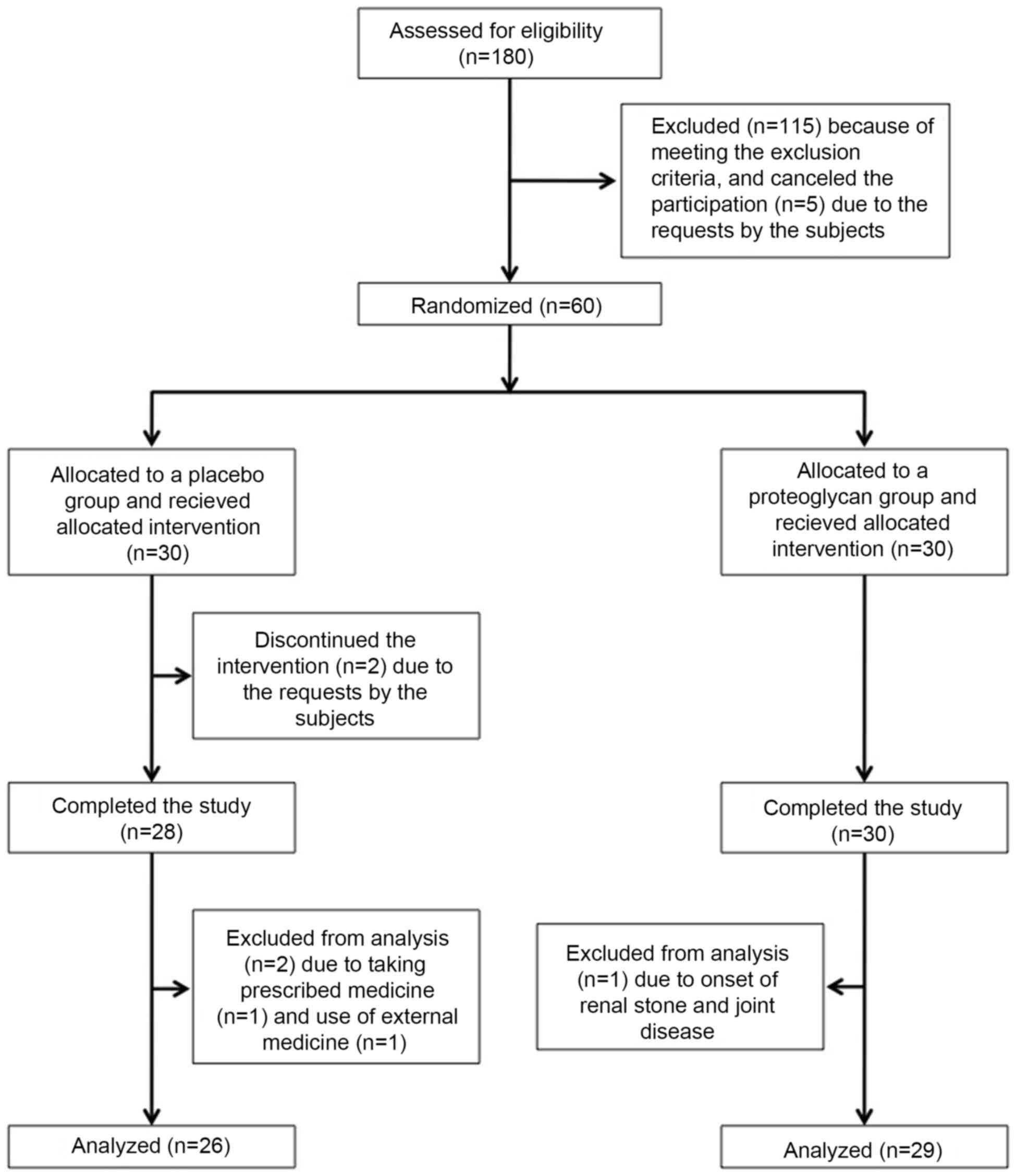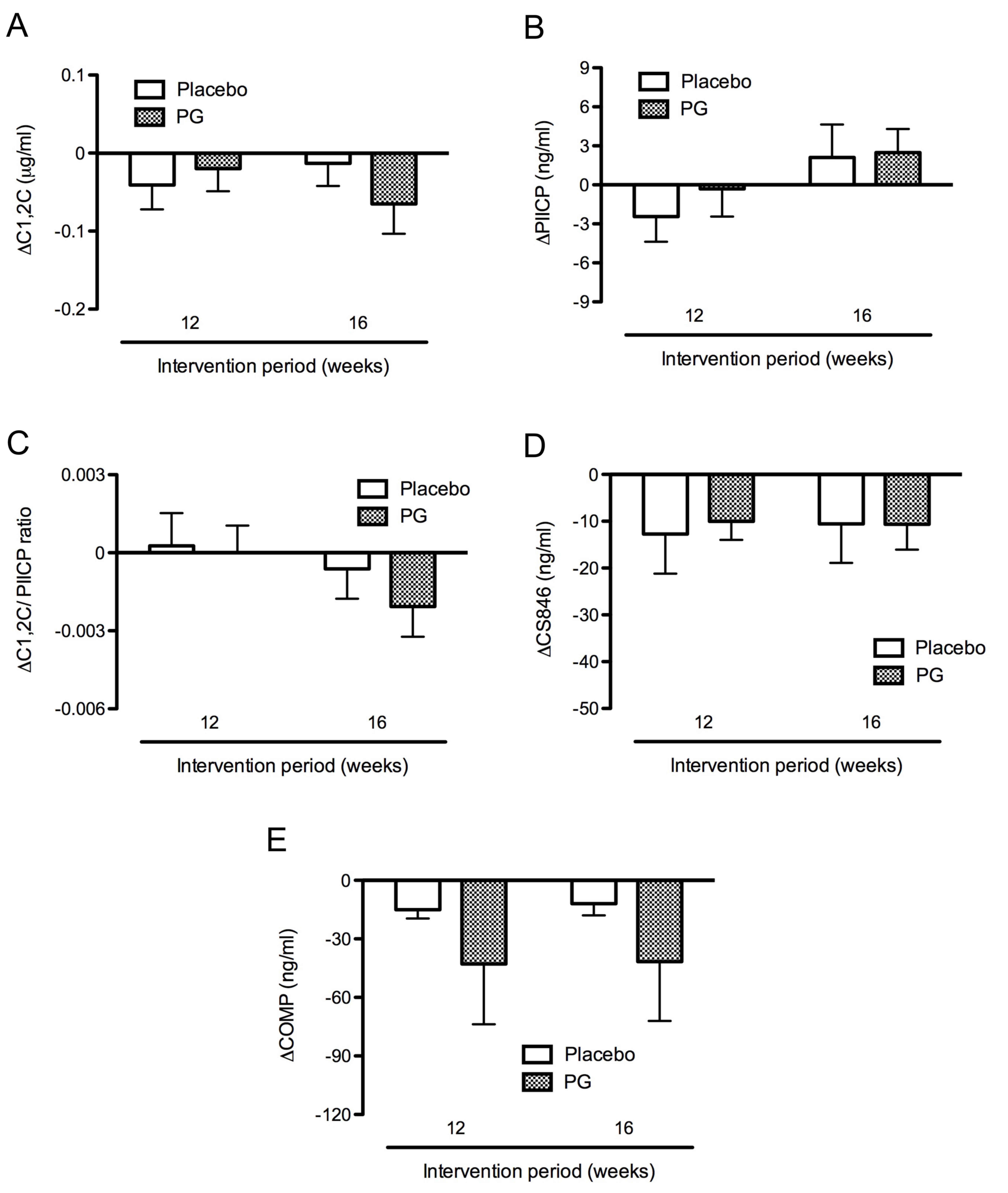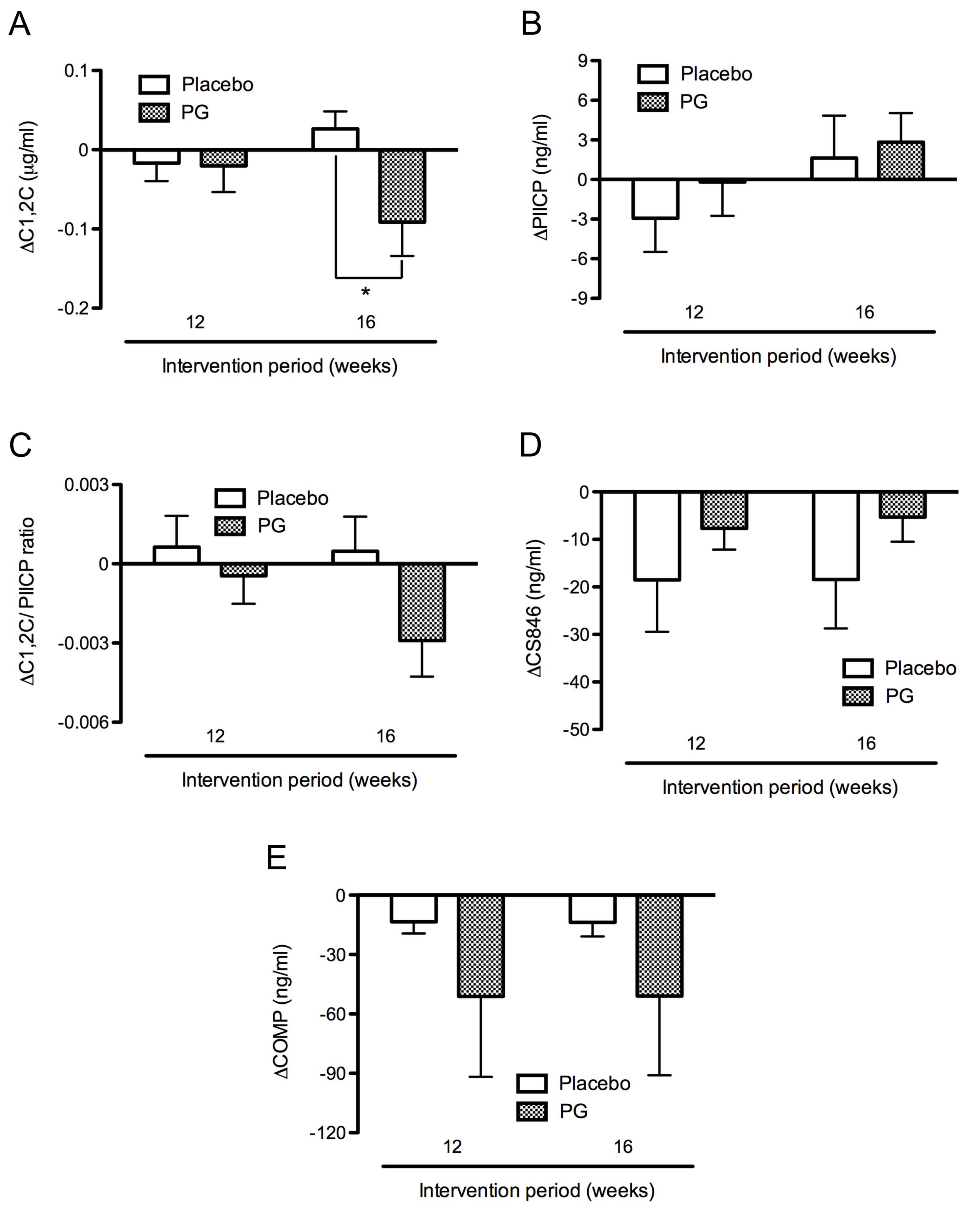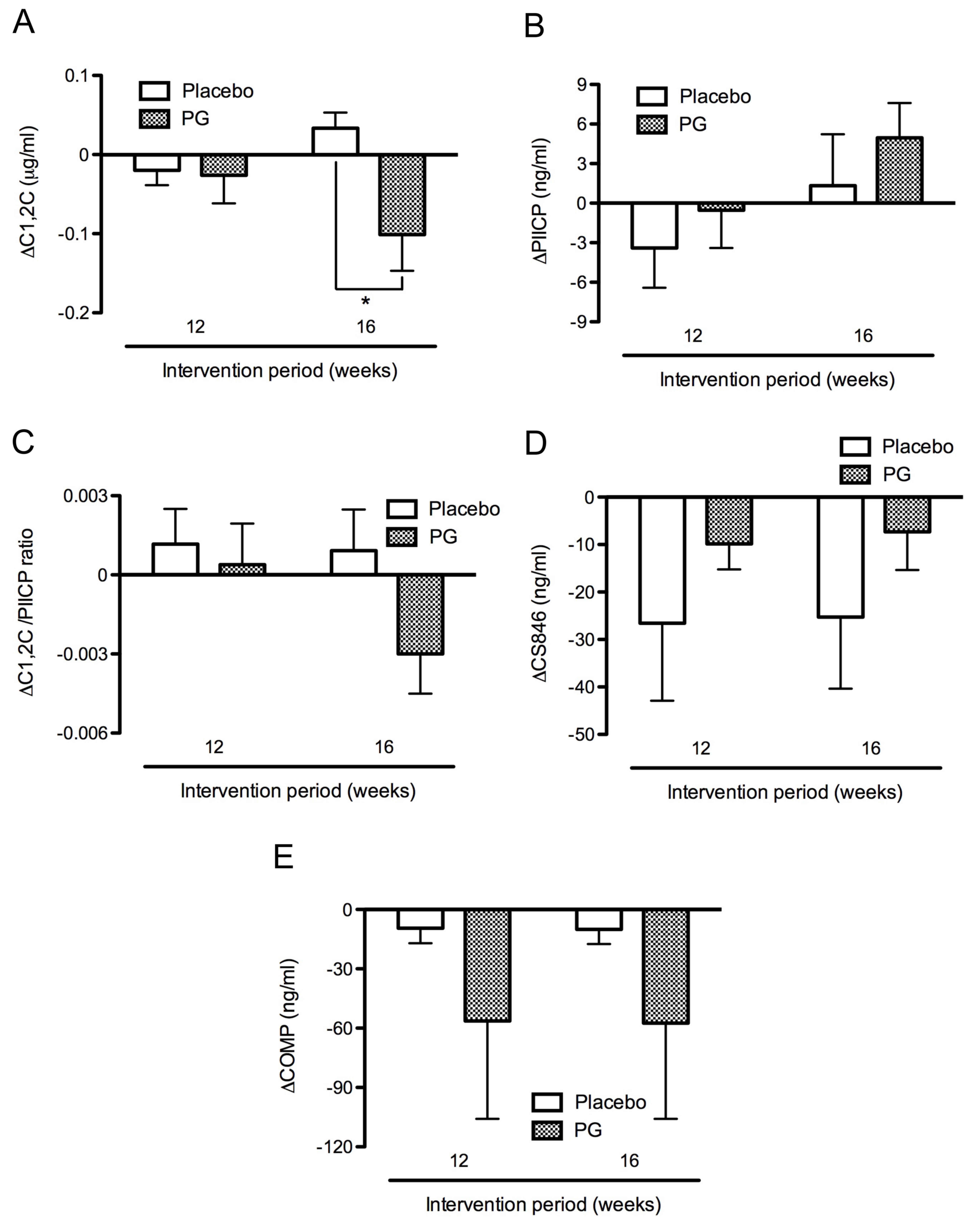|
1
|
Ravenda V, Manette C, Lemmens R, Mariani
AM, Struvay N and Reginster JY: Prevalence and impact of
osteoarthritis and osteoporosis on health-related quality of life
among active subjects. Aging Clin Exp Res. 19:55–60. 2007.
View Article : Google Scholar : PubMed/NCBI
|
|
2
|
Jinks C, Jordan K and Croft P:
Osteoarthritis as a public health problem: The impact of developing
knee pain on physical function in adults living in the community:
(KNEST 3). Rheumatology (Oxford). 46:877–881. 2007. View Article : Google Scholar : PubMed/NCBI
|
|
3
|
Yoshimura N, Muraki S, Oka H, Mabuchi A,
En-Yo Y, Yoshida M, Saika A, Yoshida H, Suzuki T, Yamamoto S, et
al: Prevalence of knee osteoarthritis, lumbar spondylosis, and
osteoporosis in Japanese men and women: The research on
osteoarthritis/osteoporosis against disability study. J Bone Miner
Metab. 27:620–628. 2009. View Article : Google Scholar : PubMed/NCBI
|
|
4
|
Qi C and Changlin H: Effects of moving
training on histology and biomarkers levels of articular cartilage.
J Surg Res. 135:352–363. 2006. View Article : Google Scholar : PubMed/NCBI
|
|
5
|
Garnero P, Rousseau JC and Delmas PD:
Molecular basis and clinical use of biochemical markers of bone,
cartilage, and synovium in joint diseases. Arthritis Rheum.
43:953–968. 2000. View Article : Google Scholar : PubMed/NCBI
|
|
6
|
Garnero P, Piperno M, Gineyts E, Christgau
S, Delmas PD and Vignon E: Cross sectional evaluation of
biochemical markers of bone, cartilage and synovial tissue
metabolism in patients with knee osteoarthritis: Relations with
disease activity and joint damage. Ann Rheum Dis. 60:619–626. 2001.
View Article : Google Scholar : PubMed/NCBI
|
|
7
|
Poole AR: Biochemical/immunochemical
biomarkers of osteoarthritis: Utility for prediction of incident or
progressive osteoarthritis. Rheum Dis Clin North Am. 29:803–818.
2003. View Article : Google Scholar : PubMed/NCBI
|
|
8
|
Elsaid KA and Chichester CO: Review:
Collagen markers in early arthritic diseases. Clin Chim Acta.
365:68–77. 2006. View Article : Google Scholar : PubMed/NCBI
|
|
9
|
Rousseau JC and Delmas PD: Biological
markers in osteoarthritis. Nat Clin Pract Rheumatol. 3:346–356.
2007. View Article : Google Scholar : PubMed/NCBI
|
|
10
|
Garnero P and Delmas PD: Biomarkers in
osteoarthritis. Curr Opin Rheumatol. 15:641–646. 2003. View Article : Google Scholar : PubMed/NCBI
|
|
11
|
Christgau S, Garnero P, Fledelius C, Moniz
C, Ensig M, Gineyts E, Rosenquist C and Qvist P: Collagen type II
C-telopeptide fragments as an index of cartilage degradation. Bone.
29:209–215. 2001. View Article : Google Scholar : PubMed/NCBI
|
|
12
|
Poole AR, Ionescu M, Fitzcharles MA and
Billinghurst RC: The assessment of cartilage degradation in vivo:
Development of an immunoassay for the measurement in body fluids of
type II collagen cleaved by collagenases. J Immunol Methods.
294:145–153. 2004. View Article : Google Scholar : PubMed/NCBI
|
|
13
|
Billinghurst RC, Dahlberg L, Ionescu M,
Reiner A, Bourne R, Rorabeck C, Mitchell P, Hambor J, Diekmann O,
Tschesche H, et al: Enhanced cleavage of type II collagen by
collagenases in osteoarthritic articular cartilage. J Clin Invest.
99:1534–1545. 1997. View Article : Google Scholar : PubMed/NCBI
|
|
14
|
Shinmei M, Ito K, Matsuyama S, Yoshihara Y
and Matsuzawa K: Joint fluid carboxy-terminal type II procollagen
peptide as a marker of cartilage collagen biosynthesis.
Osteoarthritis Cartilage. 1:121–128. 1993. View Article : Google Scholar : PubMed/NCBI
|
|
15
|
Rizkalla G, Reiner A, Bogoch E and Poole
AR: Studies of the articular cartilage proteoglycan aggrecan in
health and osteoarthritis. Evidence for molecular heterogeneity and
extensive molecular changes in disease. J Clin Invest.
90:2268–2277. 1992. View Article : Google Scholar : PubMed/NCBI
|
|
16
|
Lohmander LS, Ionescu M, Jugessur H and
Poole AR: Changes in joint cartilage aggrecan after knee injury and
in osteoarthritis. Arthritis Rheum. 42:534–544. 1999. View Article : Google Scholar : PubMed/NCBI
|
|
17
|
Vilím V, Vytásek R, Olejárová M, Machácek
S, Gatterová J, Procházka B, Kraus VB and Pavelka K: Serum
cartilage oligomeric matrix protein reflects the presence of
clinically diagnosed synovitis in patients with knee
osteoarthritis. Osteoarthritis Cartilage. 9:612–618. 2001.
View Article : Google Scholar : PubMed/NCBI
|
|
18
|
Hunter DJ, Li J, LaValley M, Bauer DC,
Nevitt M, DeGroot J, Poole R, Eyre D, Guermazi A, Gale D and Felson
DT: Cartilage markers and their association with cartilage loss on
magnetic resonance imaging in knee osteoarthritis: The Boston
Osteoarthritis Knee Study. Arthritis Res Ther. 9:R1082007.
View Article : Google Scholar : PubMed/NCBI
|
|
19
|
Jansen NW, Roosendaal G, Lundin B, Heijnen
L, Mauser-Bunschoten E, Bijlsma JW, Theobald M and Lafeber FP: The
combination of the biomarkers urinary C-terminal telopeptide of
type II collagen, serum cartilage oligomeric matrix protein, and
serum chondroitin sulfate 846 reflects cartilage damage in
hemophilic arthropathy. Arthritis Rheum. 60:290–298. 2009.
View Article : Google Scholar : PubMed/NCBI
|
|
20
|
Clayton JJ: Nutraceuticals in the
management of osteoarthritis. Orthopedics. 30:624–631.
2007.PubMed/NCBI
|
|
21
|
Nagaoka I: Recent aspects of the
chondroprotective and anti-Inflammatory actions of glucosamine, a
functional food. Juntendo Med J. 60:580–587. 2014. View Article : Google Scholar
|
|
22
|
Fenton JI, Chlebek-Brown KA, Peters TL,
Caron JP and Orth MW: Glucosamine HCl reduces equine articular
cartilage degradation in explant culture. Osteoarthritis Cartilage.
8:258–265. 2000. View Article : Google Scholar : PubMed/NCBI
|
|
23
|
Gouze JN, Bordji K, Gulberti S, Terlain B,
Netter P, Magdalou J, Fournel-Gigleux S and Ouzzine M:
Interleukin-1beta downregulates the expression of
glucuronosyltransferase I, a key enzyme priming glycosaminoglycan
biosynthesis: Influence of glucosamine on
interleukin-1beta-mediated effects in rat chondrocytes. Arthritis
Rheum. 44:351–360. 2001. View Article : Google Scholar : PubMed/NCBI
|
|
24
|
Nakamura H, Shibakawa A, Tanaka M, Kato T
and Nishioka K: Effects of glucosamine hydrochloride on the
production of prostaglandin E2, nitric oxide and metalloproteases
by chondrocytes and synoviocytes in osteoarthritis. Clin Exp
Rheumatol. 22:293–299. 2004.PubMed/NCBI
|
|
25
|
Derfoul A, Miyoshi AD, Freeman DE and Tuan
RS: Glucosamine promotes chondrogenic phenotype in both
chondrocytes and mesenchymal stem cells and inhibits MMP-13
expression and matrix degradation. Osteoarthritis Cartilage.
15:646–655. 2007. View Article : Google Scholar : PubMed/NCBI
|
|
26
|
McAlindon TE, Lavalley MP, Gulin JP and
Felson DT: Glucosamine and chondroitin for treatment of
osteoarthritis: A systematic quality assessment and meta-analysis.
JAMA. 283:1469–1475. 2000. View Article : Google Scholar : PubMed/NCBI
|
|
27
|
Reginster JY, Deroisy R, Rovati LC, Lee
RL, Lejeune E, Bruyere O, Giacovelli G, Henrotin Y, Dacre JE and
Gossett C: Long-term effects of glucosamine sulphate on
osteoarthritis progression: A randomized, placebo-controlled
clinical trial. Lancet. 357:251–256. 2001. View Article : Google Scholar : PubMed/NCBI
|
|
28
|
Pavelká K, Gatterová J, Olejarová M,
Machacek S, Giacovelli G and Rovati LC: Glucosamine sulfate use and
delay of progression of knee osteoarthritis: A 3-year, randomized,
placebo-controlled, double-blind study. Arch Intern Med.
162:2113–2123. 2002. View Article : Google Scholar : PubMed/NCBI
|
|
29
|
Takahashi T, Masutani T, Tomonaga A,
Watanabe K, Yamamoto T, Ito K, Tsuboi M, Yamaguchi H and Nagaoka I:
Influence on improvement of osteoarthritis by oral intake of
proteoglycan extracted from salmon nasal cartilage. Proceedings of
the International Conference and Exhibition on Nutraceuticals and
Functional Foods. Sapporo. Abstract P112. 2011;
|
|
30
|
Ohshika S, Ishibashi Y, Kon A, Kusumi T,
Kijima H and Toh S: Potential of exogenous cartilage proteoglycan
as a new material for cartilage regeneration. Int Orthop.
36:869–877. 2012. View Article : Google Scholar : PubMed/NCBI
|
|
31
|
Yoshimura S, Asano K and Nakane A:
Attenuation of collagen-induced arthritis in mice by salmon
proteoglycan. Biomed Res Int. 2014:4064532014. View Article : Google Scholar : PubMed/NCBI
|
|
32
|
Kellgren JH and Lawrence JS: Radiological
assessment of osteo-arthritis. Ann Rheum Dis. 16:494–502. 1957.
View Article : Google Scholar : PubMed/NCBI
|
|
33
|
Akai M, Iwaya T, Kurosawa H, Doi T, Nasu
T, Hayashi K and Fujino K: Development of new disease-specific QOL
measure for patients with knee osteoarthritis: Japanese knee
osteoarthritis measure (JKOM). J Phys Med. 16:55–62. 2005.(In
Japanese).
|
|
34
|
Okuda M, Omokawa S, Okahashi K, Akahane M
and Tanaka Y: Validity and reliability of the Japanese Orthopaedic
Association score for osteoarthritic knees. J Orthop Sci.
17:750–756. 2012. View Article : Google Scholar : PubMed/NCBI
|
|
35
|
Majima M, Takagaki K, Sudo S, Yoshihara S,
Kudo Y and Yamagishi S: Effect of proteoglycan on experimental
colitis. Int Cong Ser. 1223:221–224. 2001. View Article : Google Scholar
|
|
36
|
Takahashi T, Matsubara J, Wakamatsu K, Tsu
Da Tanaka Y, Masutani T, Yonezuka M, Ito K, Tsuji-Takayama K and
Tsuboi M: Ingestion of salmon nasal cartilage-derived proteoglycan
improves skin condition: A randomized, double-blind, controlled
study. Immun Endoc Metab Agents Med Chem. 15:160–167. 2015.
View Article : Google Scholar
|
|
37
|
Takahashi T, Maeda M, Matsubara J, Fujita
Y, Masutani T, Yonezuka M, Ito K, Tsuji-Takayama K and Tsuboi M:
Safety evaluation of industrially extracted, highly purified
proteoglycan from salmon nasal cartilatge. Pharmacometrics.
89:15–22. 2015.
|
|
38
|
Akai M, Doi T, Fujino K, Iwaya T, Kurosawa
H and Nasu T: An outcome measure for Japanese people with knee
osteoarthritis. J Rheumatol. 32:1524–1532. 2005.PubMed/NCBI
|
|
39
|
Cahue S, Sharma L, Dunlop D, Ionescu M,
Song J, Lobanok T, King L and Poole AR: The ratio of type II
collagen breakdown to synthesis and its relationship with the
progression of knee osteoarthritis. Osteoarthr Cartil. 15:819–823.
2007. View Article : Google Scholar : PubMed/NCBI
|
|
40
|
Sharif M, Kirwan J, Charni N, Sandell LJ,
Whittles C and Garnero P: A 5-yr longitudinal study of type IIA
collagen synthesis and total type II collagen degradation in
patients with knee osteoarthritis-association with disease
progression. Rheumatology (Oxford). 46:938–943. 2007. View Article : Google Scholar : PubMed/NCBI
|
|
41
|
Christgau S, Henrotin Y, Tankó LB, Rovati
LC, Collette J, Bruyere O, Deroisy R and Reginster JY:
Osteoarthritic patients with high cartilage turnover show increased
responsiveness to the cartilage protecting effects of glucosamine
sulfate. Clin Exp Rheumatol. 22:36–42. 2004.PubMed/NCBI
|
|
42
|
Cibere J, Thorne A, Kopec JA, Singer J,
Canvin J, Robinson DB, Pope J, Hong P, Grant E, Lobanok T, et al:
Glucosamine sulfate and cartilage type II collagen degradation in
patients with knee osteoarthritis. J Rheumatol. 32:896–902.
2005.PubMed/NCBI
|
|
43
|
Mazières B, Hucher M, Zaïm M and Garnero
P: Effect of chondroitin sulfate in symptomatic knee
osteoarthritis: A multicentre, randomised, double-blind,
placebo-controlled study. Ann Rheum Dis. 66:639–645. 2007.
View Article : Google Scholar : PubMed/NCBI
|
|
44
|
Conrozier T, Poole AR, Ferrand F, Mathieu
P, Vincent F, Piperno M, Verret C, Ionescu M and Vignon E: Serum
concentrations of type II collagen biomarkers (C2C, C1, 2C and
CPII) suggest different pathophysiologies in patients with hip
osteoarthritis. Clin Exp Rheumatol. 26:430–435. 2008.PubMed/NCBI
|
|
45
|
Sukhova GK, Schönbeck U, Rabkin E, Schoen
FJ, Poole AR, Billinghurst RC and Libby P: Evidence for increased
collagenolysis by interstitial collagenases-1 and -3 in vulnerable
human atheromatous plaques. Circulation. 99:2503–2509. 1999.
View Article : Google Scholar : PubMed/NCBI
|
|
46
|
Armstrong L, Tickett DR, Mansell JP,
Ionescu M, Hoyle E, Billinghurst RC, Poole AR and Millar AB:
Changes in collagen turnover in early acute respiratory distress
syndrome. Am J Respir Crit Care Med. 160:1910–1915. 1999.
View Article : Google Scholar : PubMed/NCBI
|
|
47
|
Mitsui T, Sashinami H, Sato F, Kijima H,
Ishiguro Y, Fukuda S, Yoshihara S, Hakamada K and Nakane A: Salmon
cartilage proteoglycan suppresses mouse experimental colitis
through induction of Foxp3+ regulatory T cells. Biochem Biophys Res
Commun. 402:209–215. 2010. View Article : Google Scholar : PubMed/NCBI
|
|
48
|
Tsuchiya Y, Tomita M, Tsuboi M, Takahashi
Y, Yonezuka M, Kikuchi S, Nagasawa S, Kumazawa A and Kubota J:
Absorption of proteoglycan via clathrin-mediated endocytosis in the
small intestine of rats. Biosci Biotechnol Biochem. 77:654–656.
2013. View Article : Google Scholar : PubMed/NCBI
|
|
49
|
Billinghurst RC, Wu W, Ionescu M, Reiner
A, Dahlberg L, Chen J, van Wart H and Poole AR: Comparison of the
degradation of type II collagen and proteoglycan in nasal and
articular cartilages induced by interleukin-1 and the selective
inhibition of type II collagen cleavage by collagenase. Arthritis
Rheum. 43:664–672. 2000. View Article : Google Scholar : PubMed/NCBI
|
|
50
|
Rousset F, Hazane-Puch F, Pinosa C, Nguyen
MV, Grange L, Soldini A, Rubens-Duval B, Dupuy C, Morel F and Lardy
B: IL-1beta mediates MMP secretion and IL-1beta neosynthesis via
upregulation of p22(phox) and NOX4 activity in human articular
chondrocytes. Osteoarthritis Cartilage. 23:1972–1980. 2015.
View Article : Google Scholar : PubMed/NCBI
|














